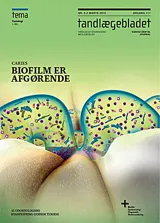Caries – en biofilmmedieret sygdom
Gennem tiden har opfattelsen af cariesætiologi ændret sig radikalt, dog har synet på cariesbehandling ikke gennemgået en tilsvarende forandring, men er fortsat hovedsageligt fokuseret på restaurerende behandlinger i store dele af verden (”drilling and filling”). Caries beskrives i dag som en multifaktoriel sygdom, hvor den orale biofilm spiller en vigtig rolle i ætiologien. En biofilm er en samling eller klynge af mikroorganismer, fx bakterier, der har helt andre egenskaber og følsomhed mod fx antiseptika, end de enkelte bakterier har hver for sig. En tynd og stabil biofilm har en vigtig beskyttende effekt mod uvelkomne patogener, mens stressede og tykke biofilm står bag 80 % af alle kroppens infektioner. Nøglen i det forebyggende arbejde er altså at tilstræbe balance (homeostase) og mangfoldighed i biofilmen/plakken ved at udnytte økologiske principper. Der er flere måder at gøre dette på, og de kan med fordel kombineres: 1) eksponering med metabolismeinhibitorer, 2) mindsket frekvens af substrat (sukker), 3) salivastimulering og 4) anvendelse af antiseptiske, antimikrobielle peptider eller probiotika. Formålet med denne artikel er kort at sammenfatte det aktuelle syn på cariesætiologi og principperne for at forebygge og kontrollere sygdommen ved at modificere biofilmen, reducere demineraliseringen og stimulere til remineralisering af tandens hårdtvæv.
Caries – a biofilm mediated disease
During the last century the perception of caries etiology have changed radically, however, the treatment of caries has not undergone a similar change, but is still mainly focused on restorative treatments in many parts of the world ("drilling and fi lling"). Dental caries is currently described as a multifactorial disease in which the oral biofi lm plays an important role in the etiology. A biofi lm is a cluster of micro-organisms such as bacteria that have completely different properties and sensitivity towards antiseptics than the individual bacteria, separately. A thin and stable biofi lm has an important protective effect against pathogens, while a stressed and thick biofi lm are the cause of 80 % of all body infections. The keypoint in prevention is therefore to strive for balance (homeostasis) and diversity in the biofi lm / plaque by using organic principles. There are several ways to do this, and they can be combined: 1) exposure of metabolism inhibitors, 2) reduced the rate of substrate (sugar), 3) saliva stimulation and 4) the use of antiseptics, anti-microbial peptides or probiotics. The purpose of this article is to briefl y summarize the current view of caries etiology and principles to prevent and control the disease by modifying the biofi lm and stimulate remineralization of the dental tissue.


